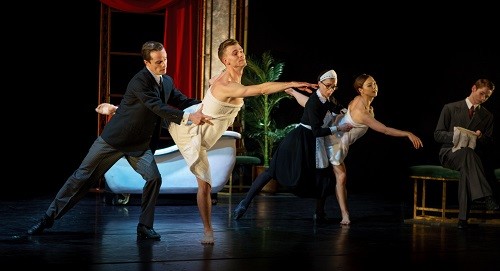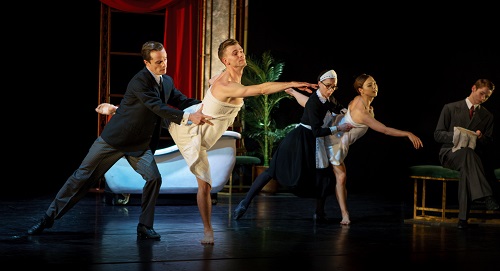 United States Various composers, Matthew Bourne’s Early Adventures: Dancers of Sir Matthew Bourne’s New Adventures, Wallis Annenberg Center for the Performing Arts, Beverly Hills, 20.05.2017. (JRo)
United States Various composers, Matthew Bourne’s Early Adventures: Dancers of Sir Matthew Bourne’s New Adventures, Wallis Annenberg Center for the Performing Arts, Beverly Hills, 20.05.2017. (JRo)

Dancers:
João Carolino, Reece Causton, Tom Clark, Daniel Collins, Paris Fitzpatrick, Sophia Hurdley, Mari Kamata, Jamie Emma Mcdonald, Edwin Ray
Production:
Watch with Mother, Town and Country, The Infernal Galop
Costume & set design – Lez Brotherston
Lighting design – Andrew Murrell
Sound design – Paul Groothuis
In Matthew Bourne’s 1991 Town and Country, everything Americans love about the British and Masterpiece Theatre – from afternoon tea to riding to hounds to Noel Coward-esque sophistication – is presented in spades. Next to Bourne’s vaudevillian tongue-in-cheek nostalgia, the antics of Jeeves and Wooster seem tame by comparison.
There’s plenty to enjoy in this romp as performed by the enthusiastic Bourne troupe of six male and three female dancers. With a wink and a nod they go through their paces, miming and dancing an inexhaustible supply of Bourne’s send-ups of upper-class city life and the country pleasures of squires, cowherds, and milkmaids. There isn’t a cliché the choreographer misses or a cow he doesn’t milk (male dancers with fingers spread wide below their backsides, while milkmaids pull on the ‘finger-teats’).
All this can be great fun if you prefer pantomime to dance. If your focus is ballet, however, the proceedings ultimately devolve into campy repetition. This is most obvious in the last piece on the program, The Infernal Galop, choreographed in 1989, which skewers the French through the lens of English prejudice. The structure is identical to Town and Country – a series of vignettes that trot out the most obvious stereotypes of the 1930s and 1940s, including three male dancers in a pissoir flirting as they pee (sound effects included). The Bourne Company calls The Infernal Galop astute satire, but this early work feels more like adolescent humor. Coming directly after Town and Country, the two feel like one long ballet of vignettes lacking narrative drive. This is exacerbated by their scores, a pastiche of, among others, Elgar, Noel Coward, Grainger, and Rachmaninoff in the first; and Offenbach, Piaf, Trenet, and Chopin in the second, which failed to supply a sense of musical unity that might have added cohesion.
First on the program, Watch with Mother (1991) explores children’s games, both fanciful and cruel, and is based on Joyce Grenfell’s Nursery School sketches. Using Grenfell’s comedic narration of a nursery-school teacher and Percy Grainger’s piano compositions, (inexplicably over-amplified and harsh), the company, dressed in grey uniforms, mime the bittersweet play of children. The three female dancers proved the most adept, their smaller scale contributing to their believability. The male dancers, tall and muscular, never felt as if they consistently inhabited their roles.
The strongest by far of the three dances, Town and Country, had its merry charms, particularly a sequence that revolves around a wealthy couple in matching bathtubs being scrubbed, dried, and dressed by their valet and maid. Mari Kamata as the bather was consistently lovely throughout the evening, the most elegant of Bourne’s dancers. João Carolino was delightful as her husband, and Daniel Collins and Sophia Hurdley as valet and maid jauntily swept the couple through their paces. The “country” section, with its clog dance and pastoral backdrop, paid homage to Frederick Ashton’s joyful ballet, La Fille mal gardée. And Beatrix Potter’s ghost wasn’t far behind, with the introduction of rabbit and hedgehog hand puppets.
As for The Infernal Galop, its one memorable section was the trio of sailors in their striped jerseys who linked arms, cocked heads, and danced in tandem like the cygnets in Swan Lake. I’m not sure why a merman was injected into the scene, but suffice it to say that, with shades of Jerome Robbins and Gene Kelly, the French sailors were adorable, thanks in part to costume designer Lez Brotherston.
There is a literal-mindedness to Bourne’s dances, more illustrative and drama centered than ballet driven. For me, he is a choreographer in search of a musical comedy, and often I expected the principals to burst into song. No doubt a musical choreographed by Bourne would wind up a hit in the West End or on Broadway.
Jane Rosenberg
